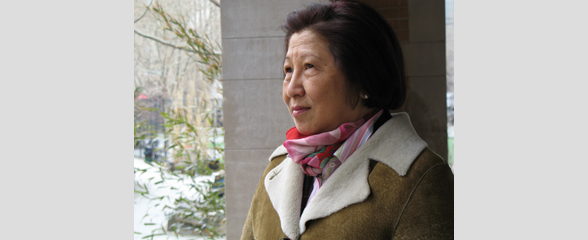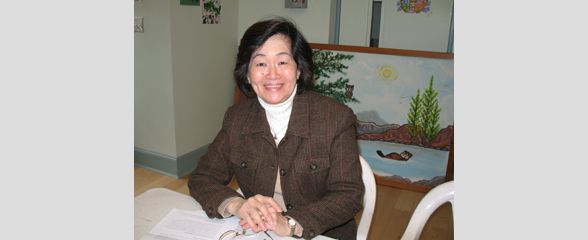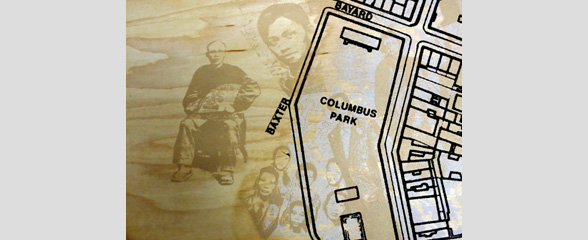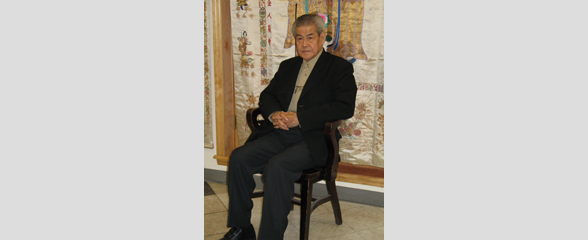 | Sio Wai Sang sits down with MOCA to discuss his experience in Chinatown since he first arrived in the 1970s by way of Macau and the Dominican Republic. He discusses his experience working as a jeweler, how he set the precedent for immigrant jewelers in Chinatown, and how the counterfeit industry has negatively affected Chinatown businesses by making them all seem cheap. He also shares his thoughts on the more close-knit community culture of Chinatown when he lived there and how he perceives it to have changed over the past several decades as the different generations come and go. Mr. Sang also talks about how he believes Chinatown should move forward and develop by creating a Business Improvement District. He believes that it will improve the commercial side of Chinatown and leave the residential side unharmed because of the internal cohesion of the Chinese community which wants to keep Chinatown Chinese. He also expresses his belief that plans for development should be approached with a cautious perspective, so new developments don’t become too commercial and harm the cultural character. |  | Spring Wang is an independent developer who was born in China and raised in Taiwan. In this oral history, she discusses her experience of moving to the United States in 1968, where she attended college and became a Marxist heavily involved in political and social movements. One organization with which she associates herself is Asian Americans for Equality (AAFE), a group devoted to talking about social services, equal employment opportunities, and housing development. She reflects on her experience in New York’s Chinatown, paying particular attention to the infrastructure and ongoing development that trickles into Soho, the Lower East Side, and Tribeca.
Events like September 11th and the global economic crisis come into play when Wang analyzes the demographic shifts in the community. According to Wang, new Chinese immigrants are more self-confident and forward-looking in contrast to earlier immigrants. She believes that because Chinatown is a small area, the institutions or physical aspect of the neighborhood is more essential than the residential population to the survival of Chinatown. She proposes that Chinatown builds larger institutions, advocating for the creation of places with more cultural spirit and symbolic significance to act as a “magnet†for the people.
|  | Toby Turkel is a Jewish woman who was born and raised in East New York, Brooklyn, and moved to Chinatown in the mid-seventies. She is an active community member, serving as the president of Chatham Towers, a co-op in Chinatown, as well as the vice president of Synagogue for the Arts. During this oral history, she begins by discussing her childhood in East New York and her personal journey that led her to live independently on the Lower East Side beginning in the sixties. Turkel later got married and moved into Chatham Towers, an apartment building located in Chinatown and predominantly inhabited by Asians. She explains how her relationship with the Chinatown community has grown over time and how she feels privileged to experience its unique culture, affectionately describing the area as “gritty†and down to earth. She also reflects on her unusual circumstance of being a non-Chinese resident of the neighborhood.
Turkel goes on to describe some of the issues affecting the Chinatown neighborhood that arise during the Chatham Tower board meetings, such as placard parking, congestion pricing, the proposed reconfiguration of Chatham Square, and the “Chinatown arch.†She also discusses the pros and cons of a proposed Chinatown Business Improvement District [BID], which would assess businesses and buildings and collect funds from landlords for community improvement. Although she recognizes there are some positive outcomes of gentrification, Turkel rejects changes that would threaten the fundamental character and distinctness of the Chinatown neighborhood.
|  | Ming Xian Lin, also known as Cindy, tells MOCA about her experience immigrating to Chinatown from Shanghai where she had worked first as a farmer during the cultural revolution and then as a telephone operator. She discusses what Chinatown looked like in the early 1990s when she arrived, going into depth about her experiences working in different garment factories and her concerns about the crime in the area. Cindy also explains how the neighborhood has changed and offers some of her thoughts about gentrification and what she thinks the government and people in the community should do about it. She also shares her thoughts on the importance Chinese immigrants learning english and how she found her drive to pick up the language at 38 years old. She concludes by discussing how she hopes her family will remain engaged with Chinatown and the broader American world. |  | Connie Ling, born in the Philippines and later a resident of Hong Kong during the 1960s, summarizes her experiences emigrating with her husband from Hong Kong to New York in 1967. Ling initially lived and worked in Chinatown, where she found employment as a machine operator in a garment factory. During her ten years working for the garment industry, Ling recalls an influx of Chinese immigrants and substantial growth in industrial businesses. After serving as a factory chairwoman for several years, she was eventually recruited as a union representative for UNITE in 1982, speaking for workers rights and mediating conflicts between workers and employers. At the time of her interview, Ling estimated that there were only approximately 100 union garment factories left. She attributes this decrease to the aftermath of September 11th, which caused commercial rent to double and garment industries to outsource labor to Sri Lanka, Mexico, and China. Ling also talks about the gentrification in Chinatown, stating that new condominiums are replacing old shops and factories while rent inflation is forcing old residents to move out of Chinatown. She goes on to note the growth among the Fukienese and Puerto Rican immigrant populations in the Lower East Side and expresses discontent with the growing number of Caucasian residents in Chinatown. Ling concludes by reflecting on how Chinatown’s garment industry is not likely to return due to significant changes in manufacturing and rent. |  | Lana Cheung emigrated with her husband from Hong Kong to the United States in 1987. Shortly after her arrival to New York, she remembers being initially surprised by the differences between Chinatown and Hong Kong, particularly in the contrasting architecture and combined residential and commercial areas. Cheung considers Chinatown a safe harbor for Chinese immigrants, where they had a sense of security and could speak their native language.
Cheung was employed by a Jewish import company, and later as a union agent for the garment workers union, UNITE (which had a Chinatown office starting in 1998). As a union representative, Cheung provides an insider perspective of the garment factory working conditions, which affected mostly Chinese immigrant women who endured long hours, hard labor, and the burden of sustaining their families. She notes that the garment factories also functioned as a place for women to communicate and socialize with each other, a detail that is often overlooked in historical accounts of garment factory working conditions.
Following September 11th, however, the garment industry slowed down and many of the garment factories were replaced by condominiums. While Cheung hopes that at least one garment facility will be preserved in memory of Chinatown’s industrial history, she otherwise welcomes the new developments and hopes that the younger and energetic generations will be a positive and reviving influence on community. Along these same lines, she acknowledges some current positive changes in sanitation, tourism, and efforts to ensure that Chinese culture and language are preserved in succeeding generations.
|  | After being petitioned by his wifes family, Sing Kong Wong, a former administrator for a government agency in China, immigrated to New York in 1980 where he worked as a presser in a garment factory. Wong illustrates the poor working conditions in the garment factories, commenting on the lack of sanitation, violations of workers rights, and inadequate benefits and welfare. He explains how the steady decline in the garment industry has been especially problematic for immigrant populations, as they are unable to find other jobs and have limited financial means to pay the rising rent. Wong believes that the decline in garment factories began with the U.S. legislation that permitted jobs to be outsourced to Mexico, China, and India. After the events of September 11th, the situation worsened as landlords demanded higher rent and as zoning changed residential areas to commercial and business spaces.
Wong mentions that as a way to remember his past life and to share important life lessons with future generations, he has photographed personal and historically significant subjects and occurrences relevant to his life and experiences. Such subjects include the harsh conditions in garment factories, life in Chinatown, and the events of September 11th. He continues to describe the changes in Chinatown occurring over the past thirty years, like the improving tolerance and relationships between ethnic and provincial groups and the greater appreciation for Chinese culture and traditions.
Finally, Wong elaborates on his views regarding gentrification, worrying that people with lower-incomes will suffer the consequences of uncontrolled rent prices, eviction, real estate development, and a poor job market. He suggests that the government should be more involved in maintaining the parks, providing more recreational programs for the community, and fixing local traffic problems. Wong asserts that progressive and proportionate improvements are necessary, but these improvements must serve all residents and not just the wealthy.
|






